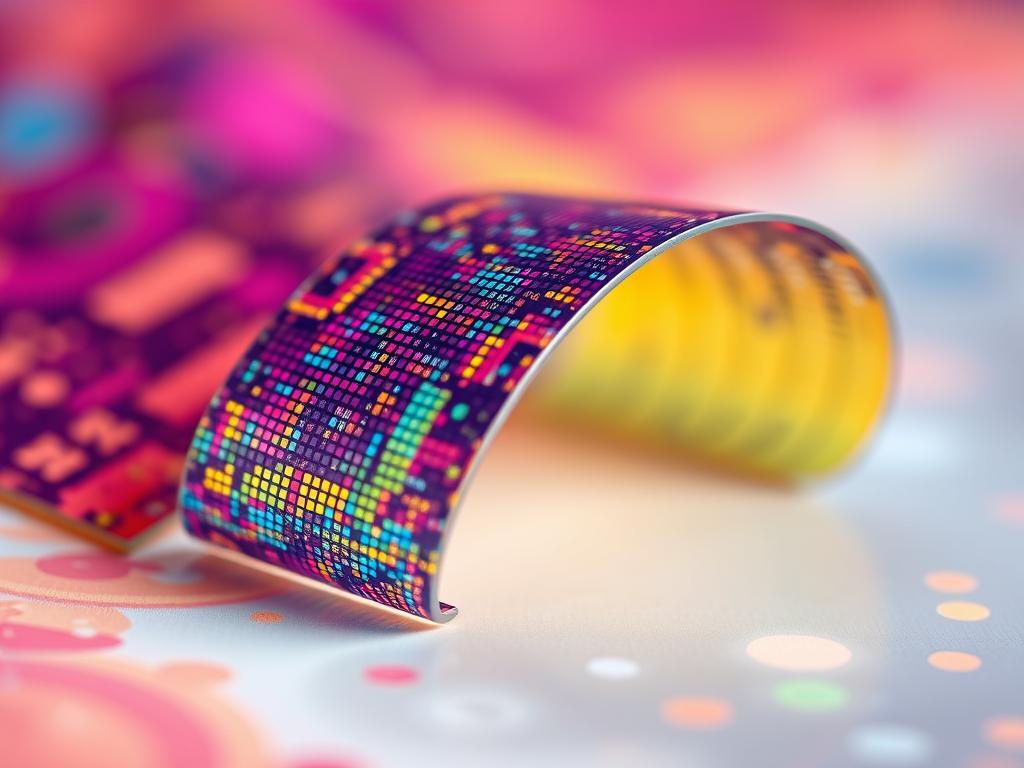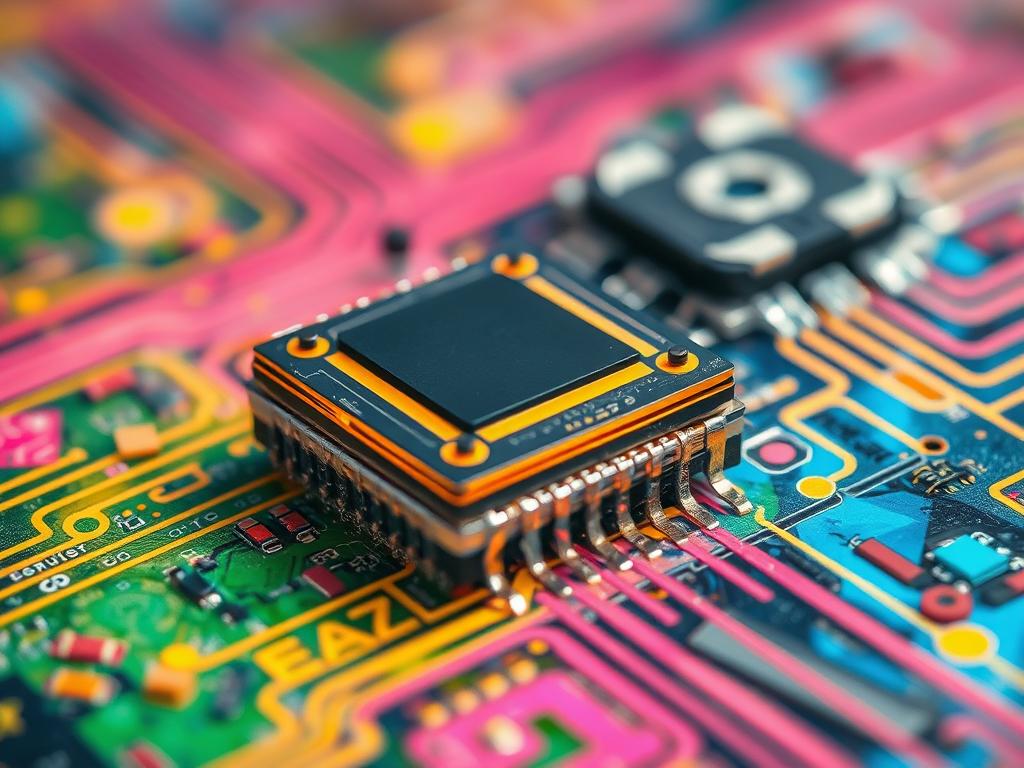Organic Field-Effect Transistors (OFETs) are changing the game in electronic devices. They use organic materials to make electronics more flexible and affordable. This makes them a big step forward in printed electronics.
OFETs are better than old-fashioned transistors in many ways. They work well on different materials and are easy to make. They might not be as powerful as some other transistors, but they’re perfect for when you need something flexible and cheap.
Key Takeaways
- OFETs offer high switching speeds and stability, making them advantageous for display technologies and flexible electronics.
- OFETs leverage unique properties of organic materials to complement other transistor types within Organic Thin-Film Transistor (OTFT) technology.
- OFETs excel in applications requiring high-speed operation and device integration, particularly useful for bioassays and neuromorphic circuits.
- OFETs are highly efficient for applications in flexible electronics and large-area displays due to their flexibility and cost-effectiveness.
- OFETs can be fabricated on plastic substrates using low-temperature solution processes, making them a versatile choice for printed electronics.
Introduction to Printed Electronics
Printed electronics is changing how we make electronic devices. It uses printing, like inkjet, to make parts like transistors and diodes. This is different from old ways that need high heat and expensive tools.
Definition and Scope
Printed electronics makes devices and circuits with printing. It works on flexible, clear, or 3D materials. This method makes it easy to make lots of electronic parts. It’s used for things like Organic Semiconductors, Large-Area Electronics, and Wearable Devices.
Historical Background
Printed electronics started in the late 1990s. Since then, big steps have been made. For example, a fully printed RFID tag was made in 2007. This field is growing fast because people want flexible, light, and cheap electronics.
| Metric | Growth Rate |
|---|---|
| Sales of silicon chips | Moderate |
| Sales of printed and thin film electronic components | Rapid |
In 2012, the printed electronics supply chain was not balanced. But now, more industries see its value. The market for printed sensors is expected to hit $7.6 billion by 2027. This shows how much people want new printed electronics.
“The introduction of printed electronics in the late 1990s has been a topic of interest for researchers and developers.”
Understanding Organic Field-Effect Transistors (OFETs)
Organic field-effect transistors, or OFETs, use organic semiconductors to control electric current. They are different from traditional transistors, which use silicon. OFETs are flexible, lightweight, and cheaper to make.
Basic Principle of Operation
OFETs work by controlling charge carrier flow through an organic semiconductor layer. When a voltage is applied to the gate electrode, it creates an electric field. This field controls the current between the source and drain electrodes.
Key Components of OFETs
- Electrodes: The source, drain, and gate electrodes are key. They help current flow and apply the electric field. Gold, platinum, or conductive polymers are often used for their conductivity.
- Semiconductor Layer: The organic semiconductor layer is crucial. It moves charge carriers. Materials like pentacene and rubrene are used for their unique properties.
- Dielectric Layer: The dielectric layer, made of materials like silicon dioxide, separates the gate electrode from the semiconductor layer. It allows for controlled electric field application.
Advantages over Traditional Transistors
OFETs have many benefits over traditional silicon-based transistors. They can be made on flexible substrates like plastic or paper. This makes them bendable and stretchable.
OFETs also have lower processing temperatures and can be made more cheaply. Organic semiconductors are flexible and durable, making them great for certain applications.
| Key Performance Metrics | Values Reported in Literature |
|---|---|
| Low Frequency Gain | 0.97 V/V (50 μm channel length), 3.2 V/V (6 μm channel length), 2 V/V (10 μm channel length) |
| Cutoff Frequency | 91 Hz (50 μm channel length), 145 Hz (6 μm channel length), 220 Hz (10 μm channel length) |
| Mobility | Ultra-high mobility (>40 cm² V⁻¹ s⁻¹) in recent reports, though mobility values can be overestimated by up to an order of magnitude due to gate bias dependence of contact resistance |
“Organic semiconductors (OSCs) remain a topic of considerable interest for basic and applied research, with charge carrier mobility being a commonly cited physical property for organic field-effect transistors (OFETs).”
The Role of OFETs in Printed Electronics
Organic field-effect transistors (OFETs) are key in printed electronics. They make devices flexible and light. This opens up new ways to make advanced electronic systems.
Flexible and Lightweight Applications
OFETs can be printed on flexible materials. This makes them great for many uses. From Flexible Electronics to Wearable Devices, they could change how we use electronics. They are light and can bend, making them perfect for small, portable devices.
These devices can even be stretchable electronics. This means they can fit into our daily lives easily.
Integration with Existing Technologies
OFETs are not just about their physical traits. They also work well with many existing technologies. This lets us make more complex electronic systems. In the Internet of Things (IoT), they help create new sensor networks and data-processing modules.
They keep the benefits of printed electronics while adding new features. This makes them very useful.
| Application | Key Advantages of OFETs |
|---|---|
| Wearable Devices | Lightweight, flexible, and conformable design |
| Smart Packaging | Integration with sensors and display elements |
| IoT Devices | Compatibility with printed circuit board technology |
As printed electronics grow, so will the importance of OFETs. They will help make devices that are flexible, light, and easy to integrate. This will be the future of electronics.
“OFETs have the potential to revolutionize the way we interact with and use electronic devices, enabling a future where flexibility and integration are the new norm.”
Manufacturing Processes for OFETs
Organic field-effect transistors (OFETs) are getting a lot of attention in Printed Electronics and Large-Area Electronics. They promise Low-Cost Fabrication. These devices use printing techniques to make production easier and cheaper.
Printing Techniques Used
Inkjet printing is a key method for making OFETs. It’s great for quick changes and small batches. The ink is made special for the layers that matter most.
Materials Characterization
The right materials are crucial for OFETs. Things like the size of the semiconductor layer and the thickness of the dielectric film are carefully chosen. This ensures the devices work their best.
Quality Control Measures
Keeping printed OFETs consistent is vital. Quality checks are done from start to finish. This helps make sure the devices are reliable and work well every time.
“The ability to fabricate OFETs using low-cost, large-area printing techniques has been a key driver in the growing popularity of this technology.”

Using printing and careful material selection, makers can create top-notch OFETs. These devices are perfect for many Printed Electronics and Large-Area Electronics uses. And they’re made affordably.
Market Overview and Trends
The printed electronics market is growing fast. It includes Wearable Devices, Internet of Things (IoT), and Environmentally Friendly Electronics. Markets and Markets say it will be worth $12.1 billion by 2022. Electronics.ca Publications also predicts it will hit over $73 billion by 2027.
Growth Potential in the Industry
Wearable Devices and IoT are boosting demand for printed electronics. There’s also a big push for green electronics. This is making electronics more sustainable and flexible.
Key Players and Innovations
Top companies are working hard to make printed electronics better. They’re focusing on Organic Field-Effect Transistors (OFETs). New printing methods, like gravure and flexography, are helping a lot.
Emerging Applications
- Electrolyte-Gated Transistors (EGTs) for bioelectronics: EGTs are stable in water, work at low voltages, and are easy to make. They’re key for better bioelectronics.
- Organic Electrochemical Transistors (OECTs) for bioelectronic applications: OECTs are made for bioelectronics. They use materials like PEDOT:PSS and P3CPT.
The printed electronics industry is always getting better. It’s becoming part of Wearable Devices, IoT, and green electronics. This will open up new chances and lead to more progress.
Challenges in the Adoption of OFETs
Organic Semiconductors are promising for Flexible Substrates and Low-Cost Fabrication of electronics. Yet, Organic Field-Effect Transistors (OFETs) face several big challenges.
Material Limitations
Organic semiconductors have big material limitations. They don’t perform as well as silicon-based transistors. This includes lower charge carrier mobility and on/off ratios.
Keeping OFETs stable and reliable is hard. It’s tough to control the material’s structure and quality in inkjet printing.
Performance Issues
OFETs struggle with charge carrier trapping and environmental instability. These issues affect their performance. They can’t handle high-speed or high-power tasks well.
Economic Considerations
Producing OFETs on a large scale is expensive. It’s hard to make them cost-effective while keeping performance high. This is a big challenge for the industry.
| Challenge | Description |
|---|---|
| Material Limitations | Inferior electrical parameters, difficulty in controlling morphology and material sophistication in printing processes, and achieving long-term stability and reliability. |
| Performance Issues | Charge carrier trapping, environmental instability, and device-to-device variations, limiting practical applications. |
| Economic Considerations | Integrating with existing manufacturing processes and achieving cost-effective fabrication methods for widespread adoption. |
Beating these challenges is key for Organic Semiconductors and OFETs to succeed. They need to work well on Flexible Substrates and be affordable for printed electronics.

Environmental Impact of OFETs
Organic Field-Effect Transistors (OFETs) are leading the way to greener electronics. They are made from organic materials and can be produced at low cost and temperature. This makes them a sustainable option compared to traditional silicon-based electronics.
The Organic Semiconductors and Flexible Substrates used in OFETs are key to reducing environmental harm. They help make these devices more eco-friendly.
Sustainability of Materials
The organic materials in OFETs, like conjugated polymers and small molecules, are more sustainable than inorganic ones. They can be made in eco-friendly ways, using less energy and waste. This is a big step towards reducing environmental impact.
The Flexible Substrates used in OFETs, such as plastic or paper, are also recyclable or biodegradable. This makes the technology even more sustainable.
Lifecycle Assessment
When we look at the whole life of OFET-based devices, we must consider many factors. These include energy use during making, how long the device lasts, and how it’s disposed of or recycled. Researchers are working hard to make OFETs even greener.
They aim to improve material sustainability and find better ways to recycle and dispose of devices. This focus on the environment could lead to a greener future for electronics.
| Key Sustainability Factors | OFET Performance |
|---|---|
| Device Yield | High, with approximately 83% yield in fabrication |
| On/Off Ratio | Around 102, showing stable electrical performance |
| Substrate Compatibility | Flexible substrates, opening up many uses |
| Long-term Stability | Keeps working well for months in different settings |
“OFETs have the potential to revolutionize the electronics industry with their environmental sustainability and versatility.”
Future Prospects for OFET Technology
Organic Field-Effect Transistors (OFETs) are making big strides in printed electronics. The U.S. OFET market was worth $0.8 billion in 2022. It’s expected to hit $2.2 billion by 2030, growing 13.6% annually from 2024 to 2030. This growth is fueled by tech advancements, rising demand, and new rules.
Potential Breakthroughs
Scientists worldwide are working on new materials and ways to make OFETs. They’re improving organic semiconductors for better performance. A big leap is the creation of OFETs that work up to 20 MHz, opening new doors for printed electronics.
Emerging Research Areas
- Hybrid devices like Organic Electrochemical Transistors (OECTs) and Organic Light-Emitting Field-Effect Transistors (OLEFETs) are being developed. They combine organic materials with other elements for better performance and flexibility.
- Researchers are also exploring how to integrate OFETs with new tech like wearable electronics and flexible displays. This uses organic materials’ unique properties.
- Improving device stability and lifespan is crucial for practical use. This ensures OFETs work well over time.
- There’s a focus on making manufacturing processes better. This includes improving printing and material testing to lower costs and increase scalability.
Industry Collaborations
The growth of the OFET market is boosted by partnerships. Companies like the University of California Santa Barbara and Graphenea are teaming up. These partnerships help share knowledge, develop new uses, and bring OFET products to market.

As OFET technology advances, it will have a big impact on printed and large-area electronics. OFETs are versatile and have many uses. They’re great for flexible displays, wearable tech, and more. With ongoing research and partnerships, the future looks very promising.
Case Studies in OFET Applications
Organic field-effect transistors (OFETs) are changing the game in many fields. They’re used in wearable technology, smart packaging, and energy harvesting devices. This shows how OFETs can make electronics lighter, more flexible, and energy-saving.
Wearable Technology
In wearable devices, OFETs make things flexible and light. They fit well on different surfaces and fabrics. This is great for smart clothes, fitness trackers, and health monitors.
The flexibility of OFETs means better comfort and less visibility. This makes the Internet of Things (IoT) more personal and comfortable.
Smart Packaging
OFETs are also used in smart packaging. They’re printed on packaging to add sensors and displays. This makes labels, food freshness indicators, and supply chain trackers possible.
OFETs are flexible and cheap to make. This makes them perfect for improving packaging’s Flexible Electronics features.
Energy Harvesting Devices
In energy harvesting, OFETs help manage power in low-power systems. They’re used in solar cells and piezoelectric generators. This boosts efficiency and stability.
OFETs work well at low voltages and on many substrates. They’re great for powering Internet of Things (IoT) devices and Flexible Electronics.
These examples show how OFETs are changing electronics. As they improve, we’ll see more uses in Wearable Devices, Internet of Things (IoT), and Flexible Electronics.
Comparison with Traditional Field-Effect Transistors
Organic Field-Effect Transistors (OFETs) stand out in the world of electronics. They are more flexible and cheaper to make than traditional transistors. This makes them great for big, flexible electronics.
Performance Metrics
OFETs show great promise in speed, stability, and power use. They aim to reach speeds of up to 20 MHz. This is a big leap from older, more complex designs.
Applications and Use Cases
OFETs are very versatile. They work well in flexible, light electronics like wearables and smart packaging. New conductive ink tech also opens up more uses for OFETs.
Cost Analysis
OFETs are also cheaper to make. They use affordable materials and flexible substrates. This makes them a cost-effective choice for many uses.

“Organic hybrid transistors, such as OECTs, are considered a new frontier in electronic device technology for enhanced performance, flexibility, and functionality in various industry sectors.”
Integration with IoT and Smart Technologies
Organic field-effect transistors (OFETs) are changing the game for Internet of Things (IoT) devices. They are flexible, lightweight, and could be cheaper. This makes them key for a future where smart tech is everywhere.
Benefits of OFETs in IoT Devices
OFETs can be printed on flexible materials. This makes them perfect for IoT devices. They help create wearable devices, flexible electronics, and more. These can fit into many products and places easily.
Real-world Applications
OFETs with IoT tech have led to many uses. We see flexible sensors for checking the environment, wearable electronics for health tracking, and flexible displays in everyday items. OFETs make IoT devices better by making them more adaptable, saving energy, and looking good.
| Application | Description |
|---|---|
| Environmental Monitoring | Flexible sensors powered by OFETs can be deployed in various environments to track parameters such as air quality, noise pollution, and weather conditions. |
| Wearable Electronics | OFET-based wearable devices can monitor health metrics, provide fitness tracking, and enable seamless integration with smart home and IoT systems. |
| Flexible Displays | OFETs can be used to create flexible, lightweight, and energy-efficient displays that can be integrated into a wide range of IoT-enabled products, from smart home appliances to industrial equipment. |
By combining OFETs with IoT and smart tech, we open up new ways to interact with our world and devices. This mix of flexible electronics and smart connections promises a future that’s more sustainable, efficient, and tailored to each person.
Regulatory Considerations
The use of Environmentally Friendly Electronics, Wearable Devices, and Flexible Electronics is growing fast. This means we need to pay more attention to the rules around organic field-effect transistors (OFETs). Companies and designers must follow many standards and get the right certifications. This ensures their products are safe, reliable, and good for the environment.
Standards and Certifications
OFETs are a new technology, so they face many rules and tests. Here are some:
- Electrical safety standards, like IEC 60950, check if electronic parts are safe for users.
- EMC standards, such as FCC Part 15, control how much electromagnetic interference (EMI) devices send out.
- Environmental standards, like RoHS and WEEE, help reduce harmful materials and make recycling easier.
Safety and Compliance
It’s also important to think about the safety and rules for OFETs. Companies must make sure the materials and how they’re made don’t harm people or the planet. They need to check if materials are toxic, can catch fire, or break down easily. They also have to watch out for any problems with electromagnetic interference or radiation.
As Wearable Devices and Flexible Electronics with OFETs become more common, following the rules is crucial. This will help win over customers and get products to market. Working together, the industry, regulators, and researchers can create strong safety standards and certifications for this fast-changing field.

Academic Research Overview
Organic field-effect transistors (OFETs) have seen a lot of research. Scientists are working hard to make them better. They are looking at new materials, printing methods, and device designs.
Current State of Research
Researchers are finding new materials for OFETs. They want to make them move faster and last longer. Rubrene single crystals have shown great results, moving much faster than usual.
They are also trying new ways to make OFETs. This includes printing them, which could make them cheaper and easier to use. This could help them be used in many different places.
Key Institutions and Contributions
Top universities and labs are leading the OFET research. They focus on materials science and electronics. They work with companies to make Organic Field-Effect Transistors, Printed Electronics, and Organic Semiconductors.
They use special tools to study how OFETs work. This helps them make better devices. It’s all about understanding how they work.
“The efficiency of OECTs is evaluated based on electron mobility, volumetric capacitance, and ion mobility factors that directly influence the device’s performance.”
The research is getting better, and the industry is excited. Soon, Organic Field-Effect Transistors will be key in printed electronics and flexible devices.
Conclusion
Organic Field-Effect Transistors (OFETs) are a key technology for the future of electronics. They offer a new way to make electronics that are flexible and printed. The work done so far has shown great promise.
These transistors are being made better and used in more ways. This makes them a strong choice for many electronics needs. Solution-processed organic thin-film transistor (TFT) arrays have shown better performance and are made more efficiently. This opens up new possibilities for making electronics in a cost-effective way.
Summary of Key Points
OFETs are great because they are light, flexible, and can be used on many surfaces. They are perfect for things like wearable tech, smart packaging, and even energy harvesting. Even though they’re not as good as some other transistors yet, they have big advantages.
They are made in a way that is efficient and can be used in many different ways. This makes them a strong choice when other transistors can’t be used. As OFET technology gets better, we can expect to see even more exciting uses in Organic Electronics and the Internet of Things (IoT).
Future Directions for Research and Development
The future of OFETs looks bright. Researchers are working to make them more stable, work faster, and be made on a larger scale. This will help them be used in more places and in more ways.
There is a lot of work to be done to overcome some challenges. But, with the help of both industry and schools, we can make big strides. This will lead to new and exciting uses of OFETs in the future.


